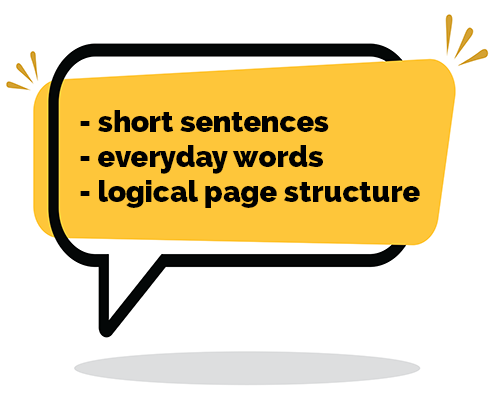Accessibility isn’t just about color contrast, focus indicators, and screen readers. The way we write matters, too.
Did you know the average American reads at a 7th- to 8th-grade level? That’s a helpful benchmark when crafting your content. Using clear, plain language isn’t about dumbing things down. It’s about making your message easy for everyone to understand, opening the door wider for all readers, not just those with disabilities.
What Is Plain Language?
The Center for Plain Language defines plain language as
Communication with clear wording, structure, and design for the intended audience to easily:
- find what they need
- understand what they find
- use that information
Plain language means communicating in a way that your audience understands your message immediately. It’s about clarity, not condescension.
Plain language is not about dumbing down; it retains meaning and strips away clutter, allowing people to focus on ideas rather than struggle through words.
Additionally, this does not mean oversimplifying; instead, you still use the correct terminology for the subject and explain it in a way your audience can understand.
Nor does it mean losing nuance; in fact, you can be precise and detailed while still being clear and concise.
At its core, plain language respects the reader: giving them the information they need, directly and accessibly.
Who Benefits from Plain Language?
- People with cognitive disabilities.
- People with learning disabilities like dyslexia or ADHD.
- People who use screen readers or text-to-speech tools.
- ESL readers and multilingual users.
- Stressed, distracted, multitasking users.
How Does Plain Language Affect Readability?
Readability refers to how easy it is for a user to understand and process a piece of text. Plain language is one of several factors that determine the readability level of that text. Plain language has a direct impact on readability in several ways:
Task Completion
The reading level and comprehension complexities of content directly affect whether people can understand instructions, process information, and complete tasks.
Using plain language improves task completion because it reduces the mental effort needed to understand instructions or information. When text is clear, concise, and free of jargon, people can quickly grasp what’s being asked of them, which means they can take action sooner and with fewer mistakes.
Cognitive Load
Overly complex written content forces readers to burn extra mental energy figuring out what the words mean, which can lead to confusion, slower comprehension, and frustration, especially for people with cognitive disabilities, low literacy skills, or those reading in a non-native language.
Using text that is clear, concise, and free of unnecessary jargon reduces cognitive load by making information easier for the brain to process.
Access to Essential Services
Poor readability can prevent people from understanding or accessing essential information, effectively excluding them from critical services. For example, complex legal language can make it difficult for someone to understand their rights or responsibilities; overly technical medical documents can stop patients from making informed decisions about their health; and government websites filled with jargon or dense formatting can prevent people from applying for benefits, voting, or complying with regulations.
Plain language removes the legal, technical, and medical terminology and replaces it with instructions, forms, and guidance that are easier to understand, resulting in reduced barriers and confusion, increased comprehension, and completion rates.
DubBot provides detailed readability scores for your web content to help you identify when your text may be too dense, overly verbose, or packed with unnecessary complexity. That information will allow you to simplify your language, improve clarity, and make information easier for all users to understand.
Applying Plain Language for Writing Accessibly
Use simple, everyday words.
For example, substitute the word use for utilize and the word buy for purchase.
Use short sentences and paragraphs.
Keep sentences to 15 to 20 words when possible, and although there are no rigid guidelines regarding paragraphs, aim for paragraphs that are 3 to 5 sentences long.
Use logical page structure and proper headings.
Organize your content for easy visual scanning and screen reader navigation. Use clear wording, logical structure, and consistent formatting.
Use plain language in ALT text and captions.
Using plain language in ALT text and captions improves accessibility, speeds comprehension, and ensures that content is inclusive for diverse audiences.
Use plain language for messaging and instructions.
For example:
Keep it Simple
Accessibility begins with clarity, and clarity starts with the words we choose. When we keep our words clear and straightforward, people understand more quickly, become less frustrated, and everyone, regardless of ability or background, can access what they need. Making content readable and understandable is one of the simplest ways to make the web more inclusive.
Resources
- Clear Writing
- Readability Scores
- Five Steps to Plain Language
- Database of Plain Language and Easy Read Guides
- Give it to Me Straight! - The Power of Plain Language
- Accessible Writing: Simple Steps to Inclusive Communication
A human author creates the DubBlog posts. The AI tool Gemini is sometimes used to brainstorm subject ideas, generate blog post outlines, and rephrase certain portions of the content. Our marketing team carefully reviews all final drafts for accuracy and authenticity. The opinions and perspectives expressed remain the sole responsibility of the human author.

